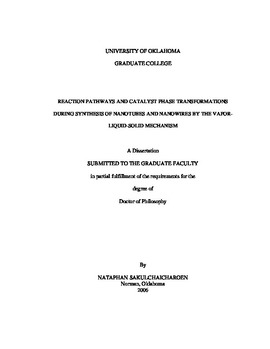| dc.contributor.advisor | Resasco, Daniel E., | en_US |
| dc.contributor.author | Sakulchaicharoen, Nataphan. | en_US |
| dc.date.accessioned | 2013-08-16T12:20:01Z | |
| dc.date.available | 2013-08-16T12:20:01Z | |
| dc.date.issued | 2006 | en_US |
| dc.identifier.uri | https://hdl.handle.net/11244/970 | |
| dc.description.abstract | The discovery of carbon nanotubes and semiconductor nanowires has initiated an exploding research field in which enormous efforts have been invested due to their fundamental significance to the study of size- and dimensionality-dependent chemical and physical properties. Extensive research work is now focused on the study of the processes that occur during synthesis of these materials since they are key essentials needed to establish a method that provides large quantities of nanotubes and nanowires with well-determined and reproducible characteristics. A clear understanding of their formation mechanism is therefore a key issue for the development of further advances in this topic. | en_US |
| dc.description.abstract | This thesis is focused on the study of the processes that take place on the catalytic particle during the growth of SWNT and SiNW using VSL processes over a cobalt molybdate and gold supported catalyst respectively. A series of analytical techniques have been employed to characterize the structure of the materials obtained and to appraise the physicochemical state of the catalytic particle. The state of Co and Mo has been investigated using laser Raman spectroscopy, X-ray photoelectron spectroscopy and Transmission electron microscopy. The chemical state of gold was studied using extended X-ray absorption fine structure spectroscopy, X-ray absorption near-edge spectroscopy, ultraviolet-visible diffuse reflectance spectroscopy and X-ray photoelectron spectroscopy. In a similar way, the SWNT and SiNW materials have been characterized using laser Raman spectroscopy, transmission electron microscopy, temperature programmed oxidation, scanning electron microscopy and optical absorption spectroscopy. The information obtained revealed that in for both SiNW and SWNT different synthesis conditions result in regimes in which different controlling rate-limiting steps determine the quantity and quality of the products obtained. | en_US |
| dc.description.abstract | To get a deeper insight onto the kinetics of SWNT growth a detailed electron microscopy study was performed. By using a model system based on silica coated TEM grids as substrate, SWNT were grown under similar reaction condition as in the commercial CoMoCatRTM process. The observations from the model system showed that CO and CH4 have different reactivity towards the cobalt molybdate catalytic particles species. Phase separation process of the pre-reduced cobalt molybdate species was observed when CO was used as feed. However, in the case of CH4 a complex alloy seems to be formed on the pre-reduced cobalt molybdate before the growth of SWNTs starts, in this case a phase separation process was not observed. These phenomena were used to explain the differences in behavior of real powder catalysts under different reaction conditions reported on previous literature. Moreover it is demonstrated how this processes affect nanotube quality, carbon yield and the chiral distribution of nanotubes structures. Indeed the (n, m) population distribution of single-walled carbon nanotubes can be controlled by varying the gaseous feed composition and the reaction temperature. The clearly different distributions obtained when varying reaction conditions demonstrate that the (n, m) distribution is a result of differences in the growth kinetics, which in turn depends on the nanotube cap-metal cluster interaction. | en_US |
| dc.format.extent | xxii, 200 leaves : | en_US |
| dc.subject | Nanowires. | en_US |
| dc.subject | Engineering, Chemical. | en_US |
| dc.subject | Nanotubes. | en_US |
| dc.title | Reaction pathways and catalyst phase transformations during synthesis of nanotubes and nanowires by the vapor-liquid-solid mechanism. | en_US |
| dc.type | Thesis | en_US |
| dc.thesis.degree | Ph.D. | en_US |
| dc.thesis.degreeDiscipline | School of Chemical, Biological and Materials Engineering | en_US |
| dc.note | Source: Dissertation Abstracts International, Volume: 67-01, Section: B, page: 0401. | en_US |
| dc.note | Adviser: Daniel E. Resasco. | en_US |
| ou.identifier | (UMI)AAI3205324 | en_US |
| ou.group | College of Engineering::School of Chemical, Biological and Materials Engineering | |
